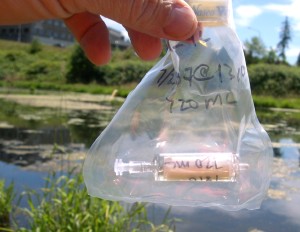Detecting Amphibian-Killing Fungus Helps Scientists Study Amphibian Declines
 USGS biologists and hydrologists are investigating the causes for the decline of the western toad (Bufo boreas) in Pacific Northwest states. One suspected cause of the decline is a fungal infection caused by the chytrid fungus Batrachochytrium dendrobatidis.
USGS biologists and hydrologists are investigating the causes for the decline of the western toad (Bufo boreas) in Pacific Northwest states. One suspected cause of the decline is a fungal infection caused by the chytrid fungus Batrachochytrium dendrobatidis.
(Image is linked to larger version) |
|
U.S. Geological Survey (USGS) scientists and their colleagues have developed a new method to detect the presence of the chytrid fungus Batrachochytrium dendrobatidis (Bd) in water and sediment samples. The Bd fungus causes chytridiomycosis, an infectious disease that can kill amphibians and has been identified as a potential cause of amphibian declines on five continents. Until the development of this new method, Bd could be detected in infected amphibians, but not in the environment they live in. This new method gives scientists a tool to help study the environmental conditions under which Bd becomes infectious, and the mechanisms by which it spreads from one place to another.
The method detects the presence of Bd DNA in water and sediment through the appropriate application and adaptation of existing protocols for collecting water and sediment samples, and a laboratory technique called polymerase chain reaction (PCR). PCR gives scientists the ability to detect the DNA of specific organisms even when their abundance is low. Now scientists can detect Bd DNA in water and sediment samples, which will help gain a better understanding of the relationship between the environmental occurrence of Bd and the incidence of chytridiomycosis in amphibians. Application of this new method will allow scientists to study the implications of Bd's presence in water bodies, to monitor water bodies before amphibian reintroduction efforts, to evaluate how climate change affects Bd occurrence and virulence, and to investigate how Bd spreads across the landscape.
 USGS biologists and hydrologists are investigating the causes for the decline of the western toad (Bufo boreas) in Pacific Northwest states. One suspected cause of the decline is a fungal infection caused by the chytrid fungus Batrachochytrium dendrobatidis.
USGS biologists and hydrologists are investigating the causes for the decline of the western toad (Bufo boreas) in Pacific Northwest states. One suspected cause of the decline is a fungal infection caused by the chytrid fungus Batrachochytrium dendrobatidis.
(Image is linked to larger version) |
|
The development of methods to detect amphibian disease in the environment is one part of the USGS's Amphibian Research and Monitoring Initiative (ARMI). ARMI is a collaborative effort of U.S. Department of the Interior agencies that is led by the USGS to determine the cause, scope, and severity of amphibian declines across the Nation.
The new chytrid method is being used by scientists both within and outside the USGS.
- The new method is now an integral part of several ARMI studies being conducted by the USGS.
- Scientists from Idaho State University and their USGS collaborators are using the new method to enhance an investigation into the pathogenesis of different strains of Bd from boreal toad (Bufo boreas) populations in Yellowstone National Park and other areas of western Wyoming.
- Scientists from Arizona State University are using the new method to study the susceptibility of different amphibian species to Bd and the role of different host species in its spread and distribution.
- Scientists from Northwest Nazarene University and their USGS collaborators are using the new method to investigate declining amphibian populations in parts of Panama and Costa Rica, where Bd infections are suspected.
|
The Amphibian Disease Chytridiomycosis
Chytridiomycosis is an infection of the skin cells of amphibians by a microscopic fungus (Batrachochytrium dendrobatidis). Death is often the result of the infection; however, exactly how the fungus causes death is not known.
More Information
- Rocky Mountain Region ARMI Projects Relating to Amphibian Disease
- Amphibian Health in Rocky Mountain National Park
- Amphibians and Chytridiomycosis, Online resources related to amphibians and chytridiomycosis, National Biological Information Infrastructure
- Chytrid Fungus Associated With Boreal Toad Deaths in Rocky Mountain National Park, Colorado, USGS New Release
- Chytrid Fungus Implicated as Factor in Decline of Arizona Frogs, USGS New Release
- Amphibian Diseases Home Page, James Cook University, Australia
- Chytrid Information Page, Longcore Laboratory, University of Maine
- Chytrid Fungus, Information from Amphibian Ark
Selected References
Corn, P.S., 2007, Amphibian and disease - Implications for conservation in the Greater Yellowstone Ecosystem: Yellowstone Science, v. 15, n. 2, p. 11-16.
Green, D.E., and Dodd, C.K., Jr., 2007 Presence and significance of chytrid fungus Batrachochytrium dendrobatidis and other amphibian pathogens at warm-water fish hatcheries in southeastern North America: Herpetological Conservation & Biology, v. 2, no. 1, p. 43-47.
Muths, E., Gallant, A., Grant, E., Battaglin, W., Green, D., Staiger, J., Walls, S., Gunzberger, M., and Kearney, R., 2006, The Amphibian Research and Monitoring Initiative (ARMI)--5-year report: U.S. Geological Survey Scientific Investigations Report 2006-5224, 77 p. |
|
Reference
Kirshtein, J.D., Anderson, C.W., Wood, J.S., Longcore, J.E., and Voytek, M.A., 2007, Quantitative PCR detection of Batrachochytrium dendrobatidis DNA from sediments and water: Diseases of Aquatic Organisms, v. 77, no. 1, p. 11-15, doi:10.3354/dao01831.
More Information
Related Headlines
Back to Headlines Page
|

|